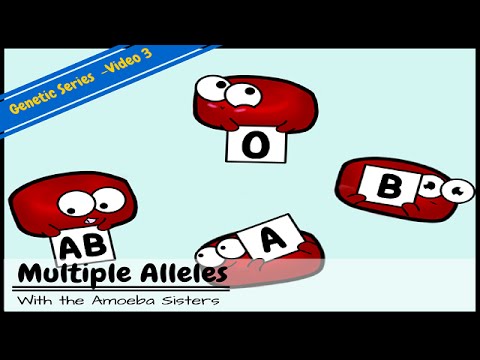11.9: Multiple Alleles
- Page ID
- 44463
Explain how mutli-allele inheritance will impact a trait within in a population
Mendel implied that only two alleles, one dominant and one recessive, could exist for a given gene. We now know that this is an oversimplification. Although individual humans (and all diploid organisms) can only have two alleles for a given gene, multiple alleles may exist at the population level such that many combinations of two alleles are observed. Note that when many alleles exist for the same gene, the convention is to denote the most common phenotype or genotype among wild animals as the wild type (often abbreviated “+”); this is considered the standard or norm. All other phenotypes or genotypes are considered variants of this standard, meaning that they deviate from the wild type. The variant may be recessive or dominant to the wild-type allele.
Multiple Alleles (ABO Blood Types) and Punnett Squares
An example of multiple alleles is the ABO blood-type system in humans. In this case, there are three alleles circulating in the population. The IA allele codes for A molecules on the red blood cells, the IB allele codes for B molecules on the surface of red blood cells, and the i allele codes for no molecules on the red blood cells. In this case, the IA and IB alleles are codominant with each other and are both dominant over the i allele. Although there are three alleles present in a population, each individual only gets two of the alleles from their parents. This produces the genotypes and phenotypes shown in the figure below. Notice that instead of three genotypes, there are six different genotypes when there are three alleles. The number of possible phenotypes depends on the dominance relationships between the three alleles. We will analyze how to do this in more detail in a section about non-Mendelian Punnett squares.

Contributors and Attributions
- Biology. Provided by: OpenStax CNX. Located at: http://cnx.org/contents/185cbf87-c72e-48f5-b51e-f14f21b5eabd@10.8. License: CC BY: Attribution. License Terms: Download for free at http://cnx.org/contents/185cbf87-c72...f21b5eabd@10.8
- ABO Punnett Square. Authored by: Charles Molnar and Jane Gair. Located at: https://opentextbc.ca/biology/chapter/8-3-extensions-of-the-laws-of-inheritance/. License: CC BY: Attribution
- Multiple Alleles (ABO Blood Types) and Punnett Squares. Authored by: Amoeba Sisters. Located at: https://youtu.be/9O5JQqlngFY. License: All Rights Reserved. License Terms: Standard YouTube License


